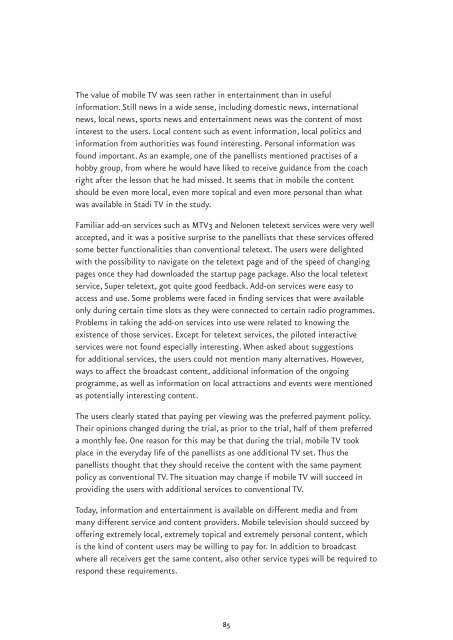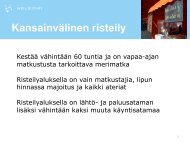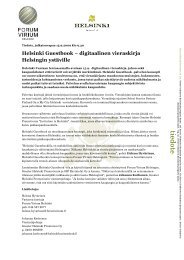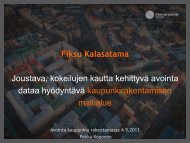FinPilot2 Final Report â User Acceptance of Mobile TV Services ...
FinPilot2 Final Report â User Acceptance of Mobile TV Services ...
FinPilot2 Final Report â User Acceptance of Mobile TV Services ...
Create successful ePaper yourself
Turn your PDF publications into a flip-book with our unique Google optimized e-Paper software.
The value <strong>of</strong> mobile <strong>TV</strong> was seen rather in entertainment than in useful<br />
information. Still news in a wide sense, including domestic news, international<br />
news, local news, sports news and entertainment news was the content <strong>of</strong> most<br />
interest to the users. Local content such as event information, local politics and<br />
information from authorities was found interesting. Personal information was<br />
found important. As an example, one <strong>of</strong> the panellists mentioned practises <strong>of</strong> a<br />
hobby group, from where he would have liked to receive guidance from the coach<br />
right after the lesson that he had missed. It seems that in mobile the content<br />
should be even more local, even more topical and even more personal than what<br />
was available in Stadi <strong>TV</strong> in the study.<br />
Familiar add-on services such as M<strong>TV</strong>3 and Nelonen teletext services were very well<br />
accepted, and it was a positive surprise to the panellists that these services <strong>of</strong>fered<br />
some better functionalities than conventional teletext. The users were delighted<br />
with the possibility to navigate on the teletext page and <strong>of</strong> the speed <strong>of</strong> changing<br />
pages once they had downloaded the startup page package. Also the local teletext<br />
service, Super teletext, got quite good feedback. Add-on services were easy to<br />
access and use. Some problems were faced in finding services that were available<br />
only during certain time slots as they were connected to certain radio programmes.<br />
Problems in taking the add-on services into use were related to knowing the<br />
existence <strong>of</strong> those services. Except for teletext services, the piloted interactive<br />
services were not found especially interesting. When asked about suggestions<br />
for additional services, the users could not mention many alternatives. However,<br />
ways to affect the broadcast content, additional information <strong>of</strong> the ongoing<br />
programme, as well as information on local attractions and events were mentioned<br />
as potentially interesting content.<br />
The users clearly stated that paying per viewing was the preferred payment policy.<br />
Their opinions changed during the trial, as prior to the trial, half <strong>of</strong> them preferred<br />
a monthly fee. One reason for this may be that during the trial, mobile <strong>TV</strong> took<br />
place in the everyday life <strong>of</strong> the panellists as one additional <strong>TV</strong> set. Thus the<br />
panellists thought that they should receive the content with the same payment<br />
policy as conventional <strong>TV</strong>. The situation may change if mobile <strong>TV</strong> will succeed in<br />
providing the users with additional services to conventional <strong>TV</strong>.<br />
Today, information and entertainment is available on different media and from<br />
many different service and content providers. <strong>Mobile</strong> television should succeed by<br />
<strong>of</strong>fering extremely local, extremely topical and extremely personal content, which<br />
is the kind <strong>of</strong> content users may be willing to pay for. In addition to broadcast<br />
where all receivers get the same content, also other service types will be required to<br />
respond these requirements.<br />
85












